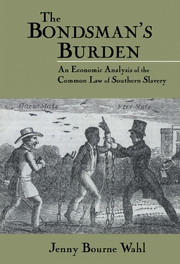Book contents
- Frontmatter
- Contents
- Acknowledgments
- 1 American Slavery and the Path of the Law
- 2 The Law of Sales: Slaves, Animals, and Commodities
- 3 The Law of Hiring and Employment: Slaves, Animals, and Free Persons
- 4 The Law Regarding Common Carriers: Slaves, Animals, Commodities, and Free Persons
- 5 The Law Regarding Governments, Government Officials, Slave Patrollers, and Overseers: Protecting Private Property versus Keeping Public Peace
- 6 The Legal Rights and Responsibilities of Strangers Toward Slaves, Animals, and Free Persons
- 7 Treatment of One's Slaves, Servants, Animals, and Relatives: Legal Boundaries and the Problem of Social Cost
- 8 The South's Law of Slavery: Reflecting the Felt Necessities of the Time
- Notes
- Index
1 - American Slavery and the Path of the Law
Published online by Cambridge University Press: 24 October 2009
- Frontmatter
- Contents
- Acknowledgments
- 1 American Slavery and the Path of the Law
- 2 The Law of Sales: Slaves, Animals, and Commodities
- 3 The Law of Hiring and Employment: Slaves, Animals, and Free Persons
- 4 The Law Regarding Common Carriers: Slaves, Animals, Commodities, and Free Persons
- 5 The Law Regarding Governments, Government Officials, Slave Patrollers, and Overseers: Protecting Private Property versus Keeping Public Peace
- 6 The Legal Rights and Responsibilities of Strangers Toward Slaves, Animals, and Free Persons
- 7 Treatment of One's Slaves, Servants, Animals, and Relatives: Legal Boundaries and the Problem of Social Cost
- 8 The South's Law of Slavery: Reflecting the Felt Necessities of the Time
- Notes
- Index
Summary
It is true, slaves are property, and must, under our present institutions, be treated as such. But they are human beings, with like passions, sympathies, and affections with ourselves.
– Turner v. Johnson, 7 Dana 435, 440 (Ky. 1838)The common law of slavery, like all of the common law, was a bridge connecting past to future. The bridge arose from the Anglo- American practice of following precedent: Once a case was decided, judges typically had to decide similar cases in the same way. To construct slave law, judges drew upon prior cases concerning free persons, animals, and other property. The outcome was a set of economically efficient rules that served as structural support for the Southern way of life.
In most contexts, efficiency means something good. Here, it was sinister: Efficient law preserved the market value of slaves and thus helped slavery flourish. But protecting property rights in slaves had other, unintended, consequences. In cases of personal injury, for example, antebellum courts tended to shield slaves more than free people. As a result, those who argued vigorously after the Civil War on behalf of ordinary consumers, workers, and victims of accidents or assaults sometimes turned to slave-law precedents for guidance. The practice of stare decisis thus meant that slave law not only built upon earlier traditions but also paved the way for later law. In fact, slave cases did serve as precedents in many types of postbellum suits. In other conflicts, the connections to slave law were less direct, either because statutory rules supplanted the common law or because older cases tend to be cited less frequently.
- Type
- Chapter
- Information
- The Bondsman's BurdenAn Economic Analysis of the Common Law of Southern Slavery, pp. 1 - 26Publisher: Cambridge University PressPrint publication year: 1997

